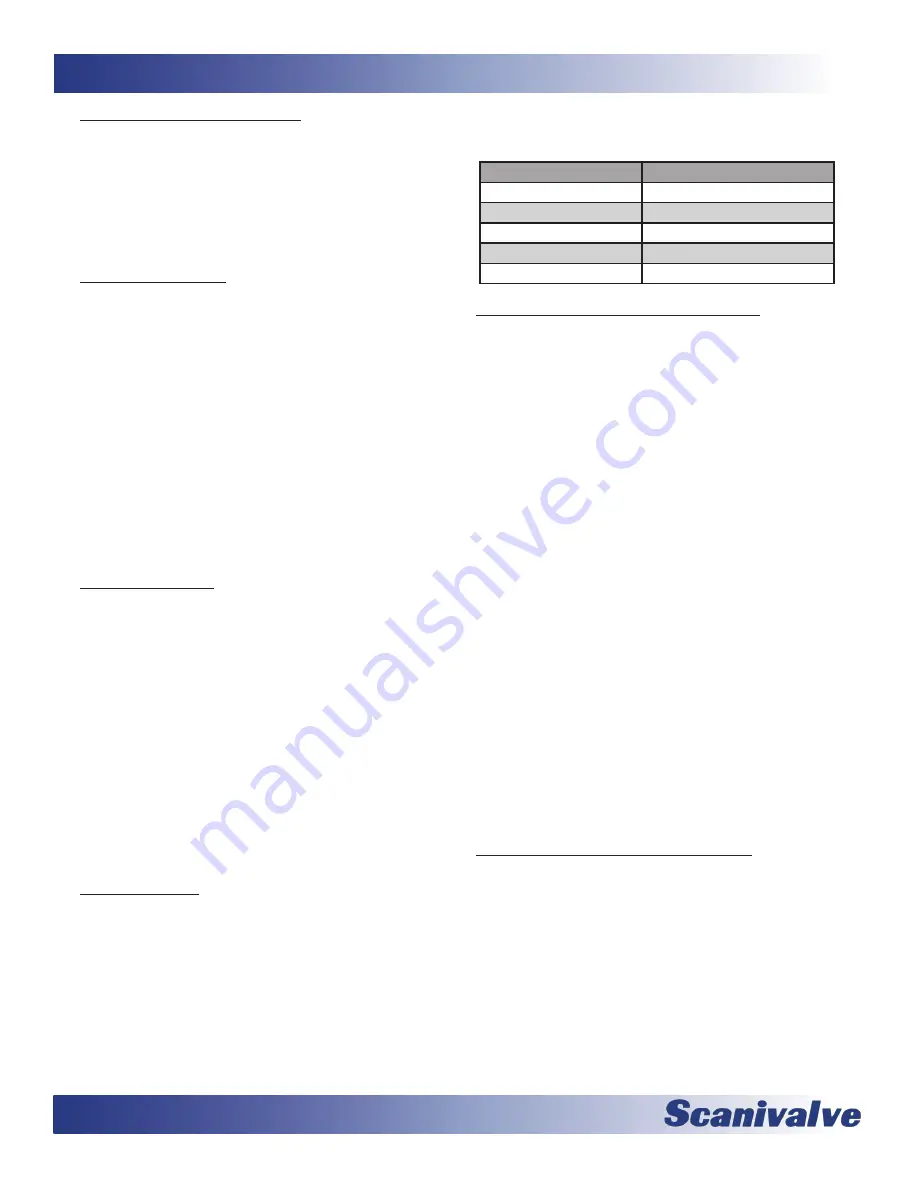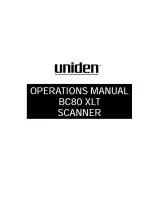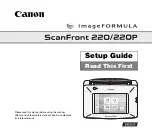
28
MPS4264
Section 4: Hardware
Pressure Measurement (Px) Ports
Each MPS4264 scanner module has 64 pressure measure-
ment ports, or “Px” ports. They are labeled as 1-64.
Each of these ports are connected to a discrete pressure
transducer. If any Px ports are not being used, it is recom-
mended that they be plugged to prevent dust or any debris
from clogging the port or contaminating the internal cali-
bration valve.
Calibration (CAL) Port
The MPS module has a single “CAL” port in the center of
the middle input header. The “CAL” port provides a means
of applying a known calibration pressure to a single port
and have it manifolded to the positive side of all of the
transducers. During normal operations when the module
is in measurement mode this port is internally blocked
off. Any pressure applied to the “CAL” port will not reach
the transducers unless the internal calibration valve has
been configured to direct the calibration pressure to the
transducers. For most low pressure applications (below
15psi) where accuracy is important, the “CAL” port should
be connected to a known, stable static location when not
being used to apply calibration pressures. This ensures
that when a pneumatic zero offset calibration (CALZ) is
performed no unwanted offsets are introduced.
Reference (REF) Port
The ‘REF’ port ties into a manifold that connects the back
side (or negative side) or all transducers together. During
most applications, the ‘REF’ port of low pressure modules
(below 15 psi) should be routed to a known, stable static
location. Typically this “reference” location will be a wind
tunnel static port, a static barrel or in flight test applications
the aircraft static system. This ensures that when a zero
offset calibration (CALZ) is performed no unwanted offsets
are introduced. During a calibration, positive pressures will
be applied through the ‘REF’ port to perform the negative
portion of the calibration.
For applications where an elevated reference pressure will
be used, the maximum pressure applied to the REF input
is 50psi.
Purge (PRG) Ports
The purge supply (PRG) port is the input for the pressure
that will be used to purge the pressure measurement
(Px) lines.
The supplied purge pressure can be up to
75psi, and must always be clean, dry instrument grade
air or nitrogen.
In order for the purge supply pressure
to successfully feed to and clear the Px input lines, the
MPS must be in Calibration/Purge mode. This is done by
applying control pressure to the “CAL-PRG CTL” port.
Recommended purge pressures are based off of the
module’s pressure range and are as follows:
Module Pressure Range Recommend Purge Pressure
4” H
2
O
1.5 PSI
8” H
2
O
3.0 PSI
1 PSI
10 PSI
5 PSI
25 PSI
15 PSI
75 PSI
Calibrate Mode Control (CAL-PRG CTL) Port
The “CAL-PRG” control pressure input is used to shift the
internal calibration valves into Calibration/Purge mode.
In this mode, the positive side of all transducers are tied
together and connected to the CAL input, and the indi-
vidual Px input tubes are manifolded together internally
and connected to the purge supply (“PRG”) ports.
The
maximum input pressure for the CAL-PRG CTL input is
120psi.
Clean, dry instrument grade air or nitrogen should
be used.
For modules that are configured with the “NPx” actuation,
90-120psi is recommended to cycle the valve completely
and reliably.
For modules that are configured with the “CPx” actuation
option, the required control pressure to cycle the valve is
60-70psi. Often this can be done with less pressure, but
60psi is recommended for reliable operation of the valve.
For “CPx” modules, in normal, low-vibration environments
the control pressure does not need to be continuously
supplied to this port to hold the valve in the Calibrate
mode. Applying the pressure for 2-4 seconds will cycle the
valve into the calibrate mode where it will stay until cycled
out using the Px CTL port. For high vibration environments,
or where it is absolutely critical that the module be held in
calibrate mode, it is recommended to continuously supply
the pressure to this port to hold the valve in the desired
state.
Measurement Mode Control (Px CTL) Port
The “Px CTL” control pressure input is used to shift the
internal calibration valve into the “Measurement” mode.
In this mode, each of the individual transducers are tied to
the discrete input (Px) tubes. The CAL and PRG input ports
are blocked off. This input port is only present on modules
configured with the “CPx” actuation option.
The maximum
input pressure for the Px CTL input is 70psi.
To actuate or
cycle the valve 60-70psi is recommended. Often this can
be done with less pressure, but 60psi is recommended for
reliable operation of the valve. Clean, dry instrument grade
air or nitrogen should be used.
Summary of Contents for MPS4264
Page 1: ...MPS4264 Miniature Pressure Scanner Hardware and Software Manual Software Version 2 07...
Page 2: ......
Page 3: ......
Page 6: ...INTENTIONALLY LEFT BLANK...
Page 12: ...6 MPS4264 Section 1 Specifications INTENTIONALLY LEFT BLANK...
Page 18: ...12 MPS4264 Section 2 Introduction INTENTIONALLY LEFT BLANK...
Page 32: ...26 MPS4264 Section 4 Hardware INTENTIONALLY LEFT BLANK...
Page 38: ...32 MPS4264 Section 5 Software INTENTIONALLY LEFT BLANK...
Page 81: ...75 MPS4264 Section 6 Maintenance INTENTIONALLY LEFT BLANK...
Page 86: ...80 MPS4264 Section 6 Maintenance INTENTIONALLY LEFT BLANK...
Page 87: ...81 MPS4264 Appendix INTENTIONALLY LEFT BLANK...
















































